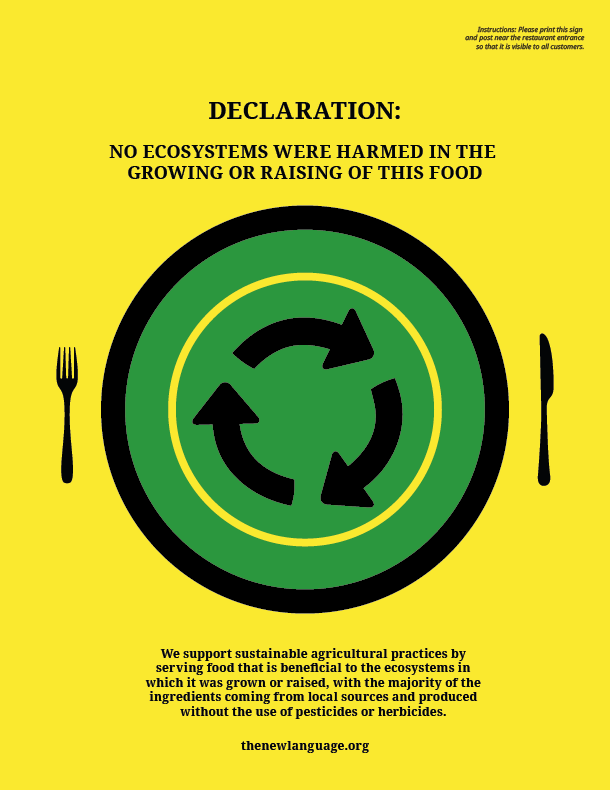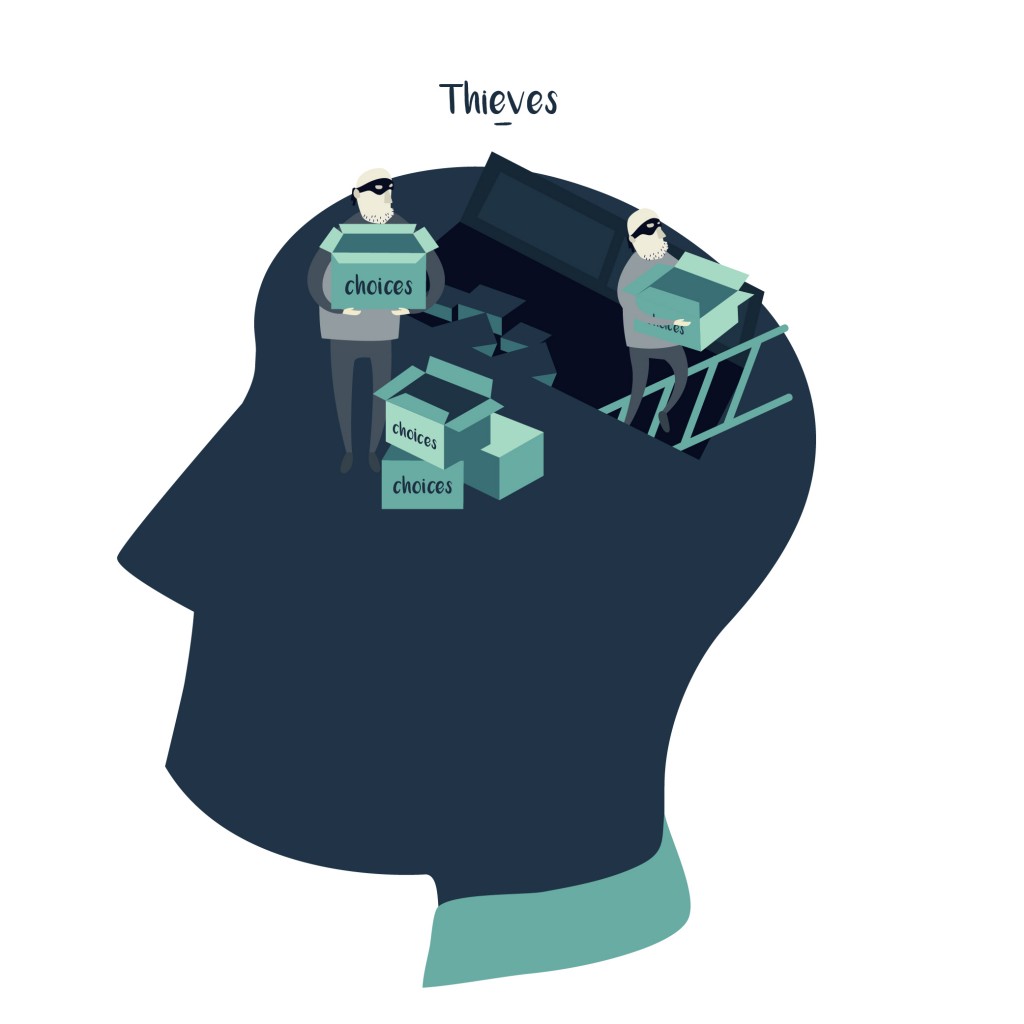The phenomenon where people stand witness to a crime or accident but fail to respond because they expect others to respond and do what is necessary. There are numerous instances of the bystander effect every day.
Category: Behavior
Chef
1) A person who, by shaping people’s tastes and establishing a demand for certain foods, protects ecosystems and supports ecologically friendly farming practices.
2) A person who facilitates eating behaviors that are adapted what the planet can produce (and do so without habit destruction).
3) A person who is knowledgeable about our existing food production systems and how those systems strain or harm our ecosystems and who seeks out food producers whose practices are complementary or beneficial to ecosystems.
4) A person capable of directing the tastes of human beings towards food sources that aid the planet’s ecosystems or complement them instead of harming them; an environmentalist.
5) A person who makes, for farmers, the growing of ecosystem-friendly crops and ecologically-friendly farming practices economically feasible—and gives farmers confidence that there is a market for what they grow and produce.
A chef can and will, for instance, develop a taste, among his or her customers, for ecosystem friendly forms of protein over steak, for example (as a steak is resource intensive to produce and the purchase of steak often contributes to deforestation, the use of feedlots and GMO corn monocultures). This behavior of chefs stands in contrast to cooks for whom the desires of customers and eating conventions (the use of imported beef or flour made from GMO wheat) take priority over the interests of ecosystems. Chefs possess the inclination and ability to interest human beings in things other than overharvested fish or energy expensive vegetables such as corn. For instance, a chef might make a dish using proteins with low energy to protein ratios (more efficient energy to protein conversion) or with perennial wheat varieties which are beneficial to the soil and often require no pesticides (as opposed to resource-intensive annual varieties, the majority of which are GMO crops that require heavy doses of pesticides and herbicides).
In addition to influencing agricultural practices and eating behaviors, chefs can increase people’s knowledge about composting and food waste.
What Are Your Choices?
What can you do? Here are some choices that are available to you.
1) Share this definition with others and be aware about our ability to advance our principles through our food choices.
2) Ask cooking schools to require courses in organic farming, soil health and cooking that requires only local, seasonal and sustainable ingredients—as well as ingredients with low calorie conversion rates.
3) Require that cooking schools be certified in sustainable environmental practices and require too that the schools accept no financial support from industrial agriculture companies.
4) Support local measures and legislation that requires restaurants to place a sign in the window that declares its chefs use primarily local, seasonal, sustainable ingredients and grades the restaurant according to its environmental practices.
5) Cook and select food using local, seasonal and organically grown ingredients.

Socially Constructed Silence
1) A tacit agreement not to talk about a particular subject.
2) A way to avoid a topic or make denial a social norm.
3) A way to make the repression of thoughts about a topic a default behavior so that the avoidance of that topic can continue indefinitely.
A socially constructed silence is a social norm where the avoidance of a topic is established through a variety of cues. People are afraid to violate this social norm and so the silence on the topic is upheld.
What Are Your Choices?
What can you do? Here are some choices that are available to you.
1) Share this definition with others.
2) You can alert others to the existence of the socially constructed silence on a topic.
3) Because the social cues that impose this silence are tacit, you can choose to be oblivious of them and discuss the topic as though doing so were not a taboo but, in fact, justified by the importance of the topic.
Disinformation Campaign
1) An effort to deprive human beings of knowledge so that they cannot see what choices are available to them.
2) A tactic used to prevent people from making decisions based on the facts or in their best interests because the facts are withheld from them, cast in doubt or buried in lies.
3) An effort by an entity or company to mislead or confuse the public about the consequences of the company’s actions in order to destroy any resistance to those actions.
4) A ploy by a company or entity to conceal harm or risks imposed on the public or to ecosystems; a way to increase informational asymmetries between the company and the public.

For example, cigarette makers were aware for decades of the dangers of smoking but claimed in public that smoking was safe. This disinformation distorted public policy in order to guard their profits.
Another example is the actions of Exxon. Exxon, whose own scientists warned as early as 1989 of the catastrophic consequences of increased CO2 levels and greenhouse gases (caused by the burning of fossil fuels), funds organizations that run campaigns of disinformation whose purpose is to sew doubt in the public’s mind about the existence or dangers of the warming of the planet. Doubt in the public about the dangers of greenhouse gases has delayed action against this threat.
One report showed that Exxon gave, despite knowing the dangers of climate change, almost $16 million from 1998 to 2005 to organizations who sought to discredit the scientific evidence related to climate change and convince the public that climate change was a hoax. Exxon also spends (if the company’s 2010 expenditure is typical) between $100 million and $300 million a year in advertising. Media companies are the beneficiaries of much of this expenditure.
See also risk asymmetry, institutional pathology and media.
Institutional Pathology
1) The inability of an institution, or the people running that institution, from ceasing to do what they know to be harmful and destructive.
2) It is where a manager’s duty to a company or organization outweighs all other concerns, including his or her concerns about the viability of the planet to support the human beings and the other species that now reside on it. It is duty to an institution being stronger than anything outside of that institution, including the concerns for his or her own family.
3) It is the mixture, among those running an institution, of a) the knowledge by those running an institution that their actions and decisions cause harm to the living systems of the planet and b) the inability or unwillingness to halt that destruction.
The duty of a manager of a corporations is definite and unqualified: it is to serve the interests of the corporation—increasing profits, avoiding risks, perceiving threats, acting so that the company is unfettered in its growth and its plans to secure profits for its owners. Furthermore, institutions often defend themselves at all costs. A company has no investment in anything but itself and so sees no cost as too great to preserve itself and its source of financial support. In short, a manager is often a servant to an entity that is indifferent to what it destroys.
This pathology results in a dilemma for managers of those institutions. It is the dilemma of being torn between their duty to the institution and their feelings of obligation towards others and toward the planet’s living systems—as well as toward the lives of future generations. One response to this dilemma may be denial among the group of people running the institution or even a culture of silence surrounding these concerns. Another response to this ambivalence may to be to adopt destruction as a social norm by subsuming it into an ideology which gives a different meaning to the act and holds it as a virtue.
Choices
What Are Your Choices?
What can you do? Here are some choices that are available to you.
1) Share this definition with others.
2) Require corporations make public all internal and commissioned studies about the environmental impacts of their actions.
3) Subject managers of corporations who violate environmental regulations to criminal prosecution and change the law so they are not insulated from the consequences of their actions.
4) Make a company’s owners and shareholders financially liable for the actions of the managers they hire to run the company or institution.
5) Alter the legal framework of companies so that the legal and ethical responsibility to ecosystems and those outside of the company are equal or greater than the legal and ethical responsibility to their employer.
See also Risk Asymmetry.
Complacency
1) A condition among sapiens that results when the beliefs, fears and rewards behind the formation of the status quo are more emotionally salient than the warnings that the continuation of the status quo will result in harms to them or others.
2) A state of inaction accompanied by feelings of satisfaction, feelings which may require the dismissal or avoidance of information by the complacent individual.
3) An individual’s denial of the role they play in the degradation of ecosystems.
For example, many enjoy feelings of satisfaction about their lives despite the continued dumping of CO2 waste into the atmosphere. These pleasant feelings discourage individuals from taking action against this dumping of CO2 (which may eventually cause the collapse of oxygen production, the collapse of certain food chains and shrinking land mass).
Superstition
1) A poor explanation for a phenomenon; a flawed description of cause and effect.
2) An explanation for a phenomenon that employs an element of magic to describe the event’s cause.
3) The use of magical thinking to predict an outcome.
One contemporary superstition is the belief that markets can cure any environmental problem. Another is the belief that human ingenuity can and will ultimately undo the destruction to ecosystems so that current societies and their behaviors can continue without interruption or change. These beliefs (which result from endowing markets and human ingenuity with magical properties) allow individuals to avoid questioning their current behaviors and what the cost of them is to ecosystems, the biosphere and the viability of the planet for human beings in the future. These beliefs can serve as a justification for inaction.